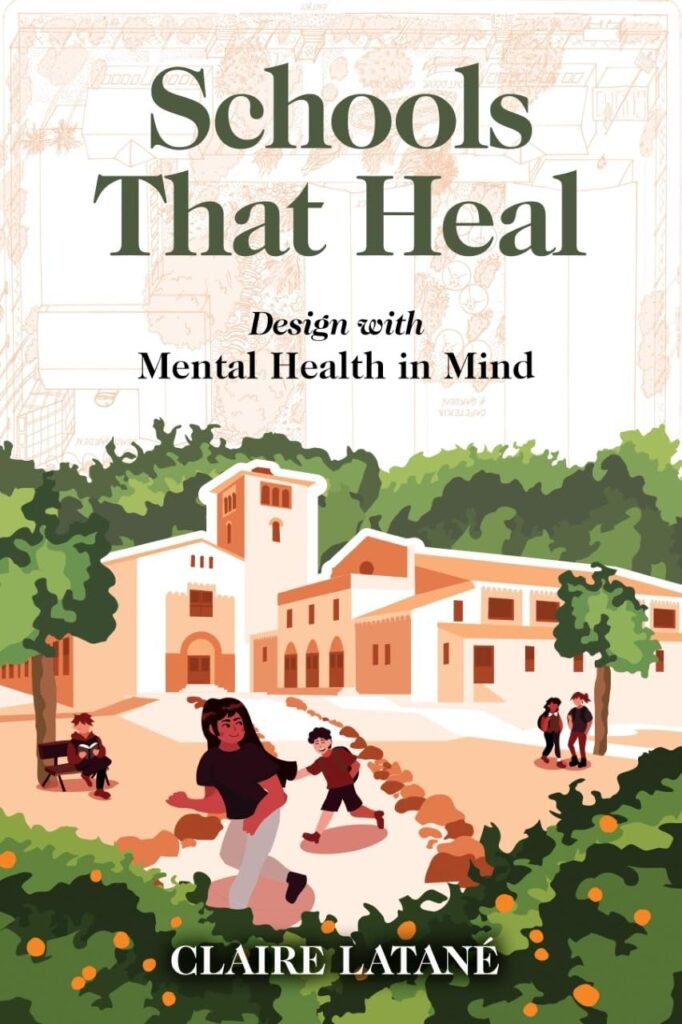Schools that Heal: How School Environments Shape Mental, Social, and Physical Health
Bioneers | Published: February 25, 2025 Ecological DesignEnvironmental EducationNature, Culture and Spirit Article

What would a school look like if it was designed with mental health in mind? Too many public schools look and feel like prisons, designed out of fear of vandalism and truancy. But we know that nurturing environments are better for learning. Research consistently shows that access to nature, big classroom windows, and open campuses reduce stress, anxiety, disorderly conduct, and crime, and improve academic performance. But too few school designers and decision-makers apply this research to create healthy schools.
In “Schools That Heal,” landscape architecture professor and designer Claire Latané details the myriad opportunities—from furniture to classroom improvements to whole campus renovations—to create supportive learning environments for our children and teenagers. In the following excerpt, learn how school environments shape mental, social and physical health, and how schools can be designed with wellbeing in mind.

Claire Latané is a landscape architecture professor at California State Polytechnic University in Pomona. Her teaching and scholarship apply research connecting the mind, body, and environment to design places and processes that support mental health. Latané has practiced landscape architecture for 14 years. She has designed interactive environments for elementary schools, middle schools, high schools, colleges, and universities as well as for affordable housing communities and public parks.
This excerpt has been reprinted with permission from Schools The Heal by Claire Latané, published by Island Press, 2021.
The average American spends 15 percent of his or her lifetime in primary and secondary school. Children and adolescents spend the majority of their waking hours there. Where we live, go to school, work, and socialize shapes how our minds and bodies function and how we relate to the world. Children and teenagers need positive and supportive school environments as they struggle to navigate their lives and futures. Overwhelming anxiety now affects nearly two-thirds of young adults. It has surpassed depression as the number one reason college students seek counseling. And suicide is now the leading cause of death for children and youth aged ten to eighteen.
In a recent survey of Los Angeles public school students, 50 percent of students screened suffered from moderate to severe post-traumatic stress disorder. Trauma-informed education is growing as a teaching approach as more school districts acknowledge that the majority of students today have experienced at least one childhood trauma impacting their ability to learn. A groundbreaking study by the Centers for Disease Control and Prevention found that nearly two-thirds of participants had endured at least one adverse childhood experience.
Plenty of evidence shows that nature-filled environments support mental health and well-being. But few designers, and even fewer school decision makers and educators, appear to be aware of the research.
The school environment—the organization and physical materials that make up a school—offers a powerful yet overlooked way to support everyone who learns, works, or otherwise finds themself there. Plenty of evidence shows that nature-filled environments support mental health and well-being. But few designers, and even fewer school decision makers and educators, appear to be aware of the research. Instead, schools too often present harsh environments with imposing fences, locking gates, window grates, and security cameras. These types of places don’t feel safer—they amplify students’ stress, anxiety, and trauma.

Supporting Trauma-Informed Education
Scientists’ understanding of the human brain has changed in recent decades to reveal a vital connection between our minds, our bodies, and the environments we inhabit. This mind-body-environment relationship means our mental health is connected to our physical health and the health of the environment we live in. All three shape who we are and how healthy we can be.
Psychologist Stephen Porges’s polyvagal theory explains why. His work connects post-traumatic stress disorder, autism, depression, and anxiety with the autonomic nervous system through the vagus nerve. This principal nerve transmits feelings of emotional well-being through our bodies to regulate our heart rate, breathing, and digestive rhythms. It also works in the other direction: when our breathing and heart rate are regular and calm and our stomach is relaxed, the vagus nerve conveys feelings of safety to our brains. When we are overwhelmed or stressed, our heart rate goes up, our breathing quickens, and our stomach feels tight. And in reverse, when our stomach aches or our heart rate goes up, we don’t feel safe.
Often, our bodies react to trauma and anxiety without our being aware of what is happening or why. We jump at the slightest noise or movement. We feel on edge while riding in a car, waiting for an accident to happen. We can’t sleep or relax. These signs of hypervigilance—being supersensitive to our surroundings—are symptoms of anxiety, post-traumatic stress disorder, and other anxiety-related disorders. Even if we don’t identify or remember the cause, our bodies do. Children and adolescents live with trauma that builds up in their bodies over time. Sometimes they remember the original physical or emotional trauma or traumas, and sometimes they don’t. Many remain unaware of the cause for their entire lives. We see the effects of trauma as aggression, irritability, skipping school, or “checking out.” This is our bodies’ “fight, flight, or freeze” response. While it is easy to visualize what a fight-or-flight response might look like, a freeze response is harder to recognize. Freeze is a state of numbness or of feeling stuck in one or more parts of the body. People in freeze often seem cooperative, quiet, or contemplative. Or they might have a hard time hearing you. Students who get in trouble for not paying attention could be in freeze. Since the likelihood is that students have endured one or more childhood traumas, trauma-informed educators suggest supporting all students as if they are impacted by trauma.
We can help children and teenagers by creating calming places where they have opportunities to both be alone and connect with other people or living beings to settle their fight, flight, or freeze response. Environments that help calm the nervous system help students feel safe.

Applying Evidence-Based Design
Nature-filled schools with hands-on and active learning and play opportunities calm students, reduce aggressive behavior, and improve learning outcomes. Being in nature helps students play cooperatively and creatively. Neighborhoods and schools with more trees have less crime and stronger social ties than neighborhoods and schools with less. By remaking schools to become welcoming, healthy, safe, and productive, we create models for students and the community to experience, learn from, and emulate in the larger world. While it sounds like common sense, these design solutions are not commonly applied. Too often, concerns about cost and long-term maintenance of supportive school environments take priority over student needs. Tight school budgets set up feelings of scarcity and competition for limited resources. Yet we can create safer, nature-filled, more beautiful school environments for the same or less money than hardened facilities and with greater chances that students and the community will take better care of them. Schools can become social and physical safety nets at the heart of our communities.
We can create safer, nature-filled, more beautiful school environments for the same or less money than hardened facilities and with greater chances that students and the community will take better care of them.
Environmental psychologist Roger Ulrich first coined the phrase “evidence-based design” in his 1984 study showing that hospital patients healed faster and needed less pain medication if they were in a room with a green view. This is one of many studies that connect nature-filled environments or exposure to nature with mental health and well-being as well as physical health. Expanding on his hospital view study, Ulrich went on to discover that the environmental conditions of psychiatric facilities impacted patient aggression. His theory of supportive design suggests that perceived control, social support, and positive distraction are integral to a patient’s well-being. The study proposed a bundle of design elements to reduce patient aggression. Primary factors are nature-filled environments and a sense of belonging.
Attention Restoration Theory
For over fifty years, psychologists Rachel and Stephen Kaplan studied which environments people preferred and how those environments affected them. Their attention restoration theory aligns with Ulrich’s work, finding that access to nature reduces stress and supports mental health and well-being. It sheds light on the types of places that make people feel most comfortable or most at home. Working with landscape architect Robert L. Ryan, the Kaplans translated their research into designable themes and spatial patterns for restorative environments—those places that best restore people’s minds after stress or mental fatigue.
The following are examples of restorative environments:
- Places that offer quiet fascination
- Places that separate us from distraction
- Places that allow us to wander in small spaces
- Places that contain materials with soft and natural textures, such as cloth, wood, stone, or weathered old materials
- Indoor places that have windows with views out to nature
To be most effective, these places should give the sense of being far away, in a setting that is large enough or designed in such a way as to hide its boundaries. A restorative place offers fascination, such as a natural setting where we can see or hear leaves or water moving or watch wildlife. And the place needs to be designed or situated so that it allows us to do what we want to do there, for instance, sit, think, eat, read, walk, or be alone.
The design strategies that support students’ mental health and wellbeing can be organized around three general themes (which are explored in more detail in the next chapter): nurture a sense of belonging, provide nature-filled environments, and inspire awe. While these themes overlap and intersect, they help us to begin visualizing specific opportunities to create more supportive school environments.

End Notes:
1. Mary Ellen Flannery, “The Epidemic of Anxiety among Today’s Students,” NEA Today (National Education Association), March 28, 2018, updated March 2019, http://neatoday.org/2018/03/28/the-epidemic-of-student-anxiety/.
2. Craig Clough, “Mental Health Screening Results of LAUSD Kids Alarming yet Typical,” LA School Report, April 10, 2015, http://laschoolreport.com/mental-health-screening-results-of-lausd-kids-alarming-yet-typical/.
3. Vincent J. Felitti et al., “Relationship of Childhood Abuse and Household Dysfunction to Many of the Leading Causes of Death in Adults: The Adverse Childhood Experiences (ACE) Study,” American Journal of Preventive Medicine 14, no. 4 (May 1, 1998): 245–258, https://doi.org/10.1016/S0749-3797(98)00017-8.
4. Alex Shevrin Venet, “The How and Why of Trauma-Informed Teaching,” Edutopia, August 3, 2018, https://www.edutopia.org/article/how-and-why-trauma-informed-teaching.
6. William C. Sullivan, “Landscapes of 20th Century Chicago Public Housing” (paper presented at the Vernacular Architecture Forum, Savanna, GA, May 1, 2007), https://www.researchgate.net/publication/275032357_Landscapes_of_20th_Century_Chicago_Public_Housing; Rodney H. Matsuoka, “High School Landscapes and Student Performance” (PhD diss., University of Michigan, 2008), https://deepblue.lib.umich.edu/handle/2027.42/61641.
This excerpt has been reprinted with permission from Schools The Heal by Claire Latané, published by Island Press, 2021.

